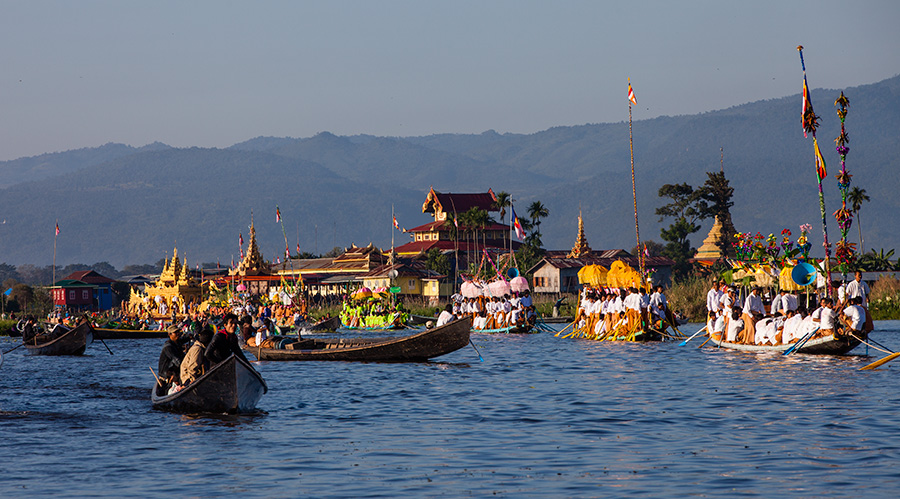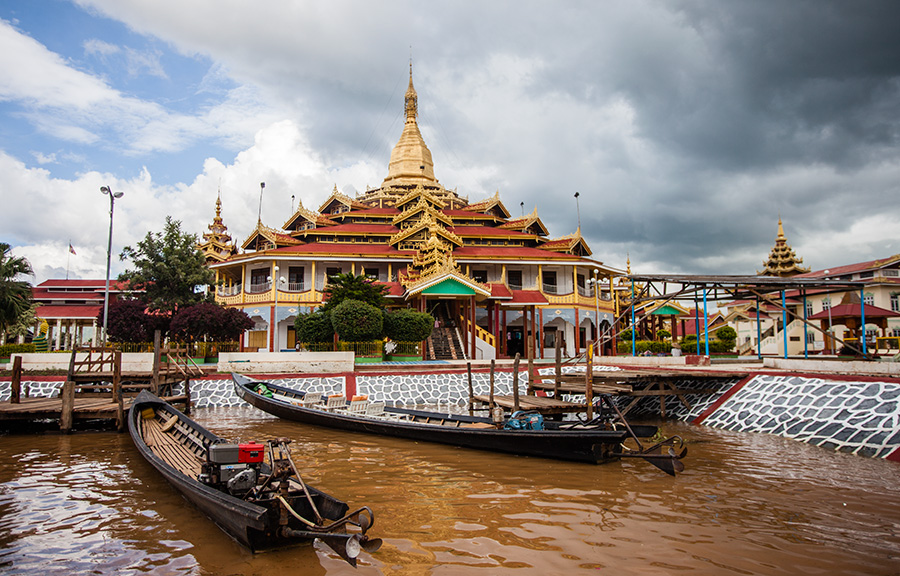Phaung Daw Oo Pagoda Festival, Inle Lake, Myanmar
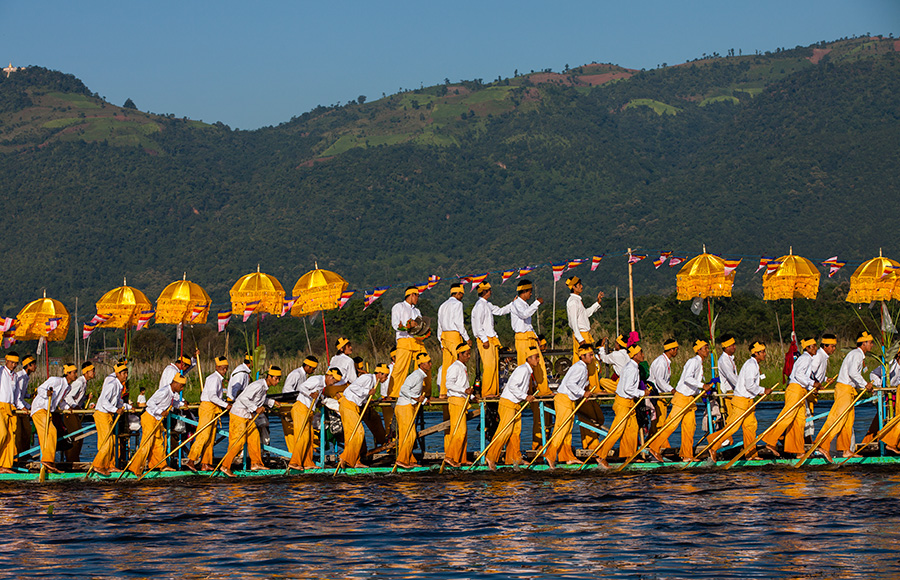
Also see: Our photography tour to Myanmar in October
It was a festival morning. About a hundred or so boats had gathered as a long thick band in the middle of the lake, waiting for the procession to pass by. A hundred boats would seem like a lot, but against the scale of the lake that is spread more than a hundred sq kilometers, the boats did not make up to much. As we approached the place of all the action, I heard the sound of bells at a distance to my left, somewhere in the vicinity of a monastery in Lin Kin Village. The procession was about to begin. Today’s procession was to take four Buddha idols of Phaung Daw Oo pagoda from Lin Kin to Nyaung Shwe town.
Inle Lake sets out for this festive celebrations every year in October-November months. The procession of Buddha images begins from their temple of residence–the Phaung Daw Oo pagoda–and crisscrosses every village in the lake taking eighteen days before returning home. Everyday, as Buddha moves from village to village, entire community gathers together to escort the parade with great fanfare. Every village decorates a long boat that will be part of the ‘boatcade‘. Each boat, carrying more than a hundred people rowing in sync to music, escort a gilded boat carrying the four golden Buddha images slowly glides over the lake. But one Buddha image continues to stay out of the festival.
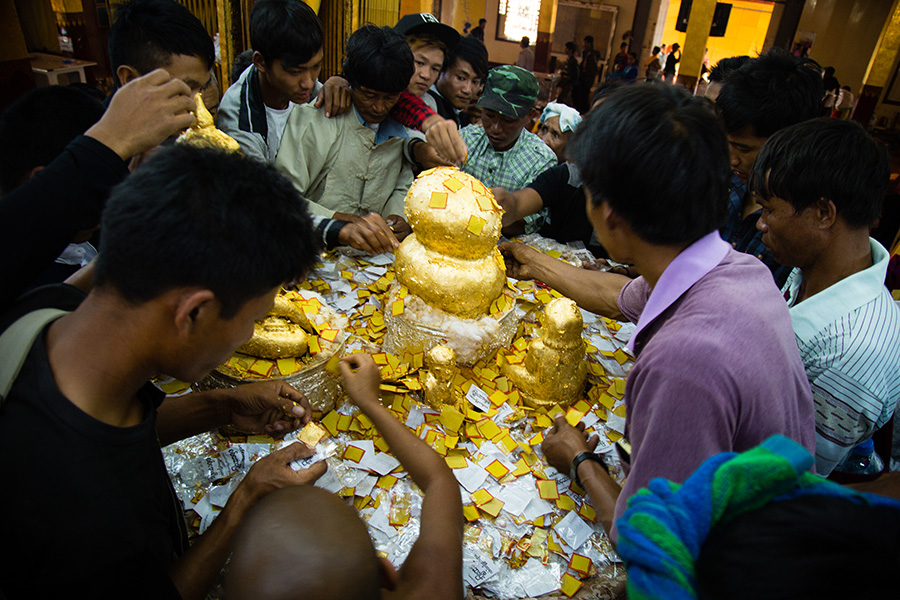
The Buddha image that remains in the pagoda during the festival. Over many years of applying gold leaf over them, the Buddha images in Phaung Daw Oo pagoda have lost their original image and appear like a blob, as seen in the image. This photograph courtesy of Andrei Forclaz.
This fifth Buddha image–the one that doesn’t go on the procession–has an enigmatic story in its exclusion from the celebrations. About fifty years ago, the boat with the Buddhas capsized during the procession and all the five idols fell into water. People dived in immediately and retrieved four of the five images, but the fifth one was not to be seen despite looking for it for hours. When the search was finally called off and people returned to Phaung Daw Oo pagoda with just four Buddhas, the fifth missing image was mysteriously installed in the pagoda already. Ever since, only four retrieved Buddhas are carried around in the procession, leaving the fifth one behind.
That morning, as we approached the band of boats waiting for the gilded boats to pass by, we could feel the excitement in the air amplified by the distant sounds of music. People gently pushed their boats ahead of the rest, trying to move as close to the center as possible. The morning breeze made me shiver occasionally, even as the sun shined brightly and glistened in the small waves of the deep-blue lake surface. At the edge of the lake, where the Shan Hills raised steeply from the lake shore, morning mist was slowly moving away to reveal the green slopes. The long line of boats had just begun moving.

The Intha people row the boats using their legs.
Each boat is about a hundred feet long, probably holding as many people in two long lines. Everyone rows together using their legs, choreographing their way forward in the procession. Yes, using their legs. The Intha people of Inle Lake are known for their unique ability to paddle by pushing the oar with one leg. On this procession too, the rowers are not seated, but are standing and rhythmically dancing together as they push the boat ahead with one leg.
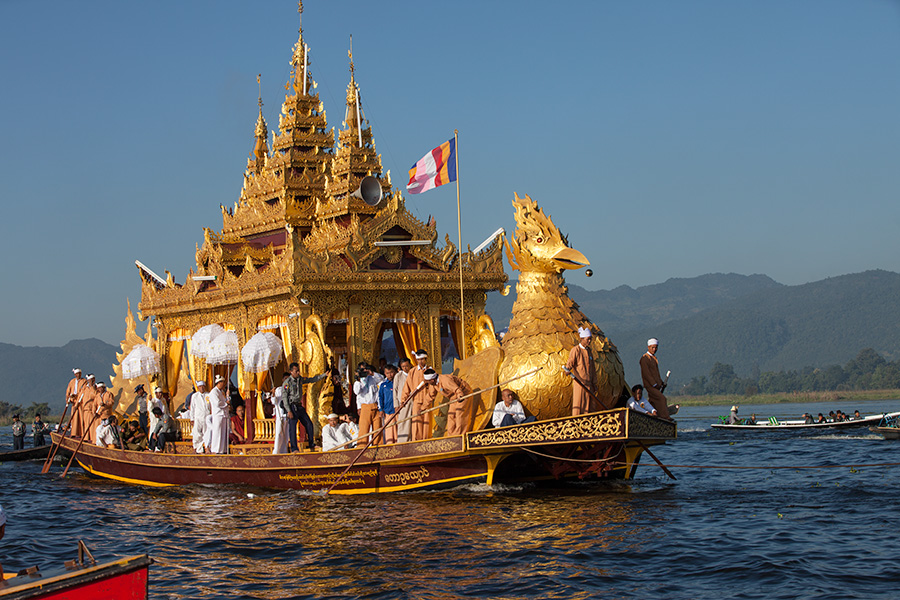
The gilded boat carrying the four Buddha images.
Boat after boat passes by, as onlookers await the gilded barge carrying the four Buddhas. On occasions, I turnaround from watching the processions and indulge in people watching. Most of the crowd is made up of people from nearby villages, with occasional tourists among them. There are a few boats filled with monks, standing clear from the crowd with their bright-ochre robes. The women of PaO community–people who live up in the hills–are very striking among crowd with their colourful headgear. Everyone is staring intently at the procession, waiting for the Buddhas to pass.
The entire drama lasts almost an hour. At the end of it, the onlooking boats chase the procession until the lake narrows into a small canal that leads towards Nyaung Shwe, the next stopover. Subsequently, where the channel is too narrow to follow the procession, everyone including us disperse and spread across the lake on the way back. The procession would land in the town in a short while, where more festivities and more crowds await the Buddhas.
Phaung Daw Oo Pagoda Festival – Information
The Phaung Daw Oo pagoda festival is held every year in October-November months. As the festival follows Burmese calendar, dates vary every year.
The festival lasts for eighteen days, with the inauguration and a procession on the first day. Each day of the festival begins with a procession as the Buddhas are shifted from village to village until all the villages on the lake are visited. The best day to see the procession is perhaps when it moves from Lin Kin to Nyaung Shwe, as this route is through a wide-open section of the lake.
Reaching Inle Lake: Nyaung Shwe is the nearest large town located on the lake shore. Regular nightly buses ply from Yangon, Mandalay and Bagan (Nyaung Oo) to Nyaung Shwe. Several flights connect Inle’s Heho Airport with Yangon, Mandalay and Bagan. Trains are also available from Yangon and Mandalay, although they can be painfully slow and not preferred over buses.
Also see: Our photography tour to Myanmar in October

